Return to table of contents
A Brief Look at
THE HISTORY OF CANOE SAILING IN NORTH AMERICA
SAILING CANOES
To begin the story the reader must travel back in time to the 1870’s. Those were the
days when Custer was still fighting Indians and much of the country was still not mapped.
People traveled around on horseback or in wagons or in boats. Farms, towns, and cities grew
up around the waterways and much more shipping and traveling was done over water. A
greater percentage of the people were familiar with boats and with sailing. Also, the people
of the East Coast used the language more the way it was used in England.
John Macgregor designed a craft modeled on the "Esquimau" boats he had seen on
his travels in North America in 1859. He called these boats "canoes" and named his Rob
Roy after a member of the family. Actually, he designed four of them and used them for
travels, starting in 1865, around Europe and the Middle East. His books did much to make
the canoe popular. At about the same time another Englishman, Warrington Baden- Powell,
designed and built another canoe which he called the "Nautilis", which also went through
several models. Under Macgregor’s leadership they formed the Royal Canoe Club in1866.
In North America, another journalist, William L. Alden, had a canoe made by James
W. Everson which followed the lines of the Nautilus No. 4, and was named the "Violetta".
He influenced some of his fellow sportsmen to take up canoeing and founded the New York
Canoe Club in1871.
These canoes, which we would call kayaks today, were cruising boats intended for
making trips lasting several days. They were made by European building techniques, cutting
pieces of wood and fastening them together with nails and screws and bolts. They did not
originate from the birch bark canoe and had nothing to do with it. They had cockpits in
which they slept and, from the very beginning, centerboards and rudders.
In a similar manner to other yachtsmen, they started racing with the first official
canoe sailing race on Flushing Bay, October 21,1871. The race was won by Montgomery
Schuyler in the "Gretchen", built in England. The New York Canoe Club had sixteen
members that year.
J. Henry Rushton began building canoes in 1876 and his first sailing canoe, Alden’s
Vesper, was soon added to his catalogue. William P. Stephens was building canoes in New
Jersey before 1880.
The American Canoe Association was formed in 1880 at Lake George. They held
annual Encampments at various places and started a series of competitions. The first was the
ACA record in1884, which was a combined paddling and sailing trophy. The Sailing trophy
was added in 1886.
In 1886, at the Annual Encampment at Grindstone Island in the Saint Lawrence River,
an important Regatta took place where the competition was primarily amongst various styles
of canoes. The British canoes, sailed by Baden-Powell and Stewart, were of the Nautilus
type, larger and heavily ballasted. The American canoes, Gibson’s Vesper, built by Rushton,
and Barney’s Pecowsic, built by Fletcher Joyner, were much lighter and without ballast.
Paul Butler even had a canoe with a sliding seat he had just invented.
The Americans very soundly defeated the British with the Vesper’s winning the first
race and the Pecowsic’s winning the consolation race. Gibson and his Vesper also won the
ACA Sailing trophy. This Regatta established the racing superiority of the light, specialized,
racing sailing canoe and especially the smooth-skinned and technically rigged Pecowsic.
From that point on the builders designed canoes and the rules were changed to develop the
sailing canoe as a highly specialized racing machine!
By 1903, when the ACA had purchased Sugar Island and started its National
Encampment there, the rules stated that the sailing canoe be no longer than 16 feet nor wider
than 30 inches but for each decrease of length of 1 inch there could be an increase of width of
1/8 inch. They could carry 112 square feet of sail area.
There was also a "Cruising Class," where the boats had to have a cockpit in which the
sailor could sleep, and a Special Class which could be 17 feet long and 42 inches wide, and
also required a cockpit for sleeping, and no seat could extend outboard of the gunwale.
In 1901 draft sails were introduced and Farnham Dorsey won the Sailing Trophy at
Sugar Island, and most sailors changed from the old batwing sails that were originally used.
In the pictures of the time, most of the canoes are ketch rigged with Gunther type rigs.
After the new International class rules in 1934, this kind of Sailing Canoe, which had
originated as a canoe for taking long trips, sometimes sailing and sometimes paddling and
sleeping in the canoe, had developed into a strictly racing sailboat. Few of the old canoes
have been preserved.
The design and development of the new wider, planing hulls was carried on mostly by
individuals. Louis Whitman designed the Manana and the Phoenix, which hulls he had cold
molded in Sweden. Most of the canoes were made of wood by individuals and were one of a
kind. However, in the 1950’s, hulls of molded plastic with fiberglass and other fiber
reinforcement were introduced, and the ICF went to a one-design hull.
Now, in the first decade of the 21st Century, most of the canoes are made by groups
of canoeists in the US and Canada who have made molds which take advantage of variations
allowed by the rules, to make theirs, hopefully, the fastest. Possibly one might be purchased
by usually only used canoes are available. Every two years there are World Championships,
but the old "Challenge Cup" Sailing Trophy and others are still contested.
CRUISING CANOES
Cruising canoes are exactly like what the title suggests. They are canoes built of wood
for day paddling and for taking long trips with camping gear. They were originally developed
for paddling with no thought of sailing.
In the Rice lake region of Ontario, in 1858, I.S. Stephenson developed and built
canoes of basswood in the general shape of the birch bark canoe but built of lightweight strip
planking and narrow ribs tacked and screwed together in the European boat building style. This
was followed by the establishment of several companies which became the Peterborough,
William English, Rice Lake and others, making this type of canoe. These canoes became the
most used canoes in paddling racing in Canada and the United States and continued as such
until the Second World War.
The American Canoe Association held an Annual Encampment every year after its
founding at Lake George in 1880. Many of the early encampments were in southern Ontario,
including the Thousand Island region of the Saint Lawrence River. As usual, when sportsmen
get together they start to set up various forms of competition and so contests in sailing,
paddling, tilting, overturning and emptying and other ways of handling canoes were initiated.
The first Championship officially recognized was the ACA Record in l884. This was a three-
race series of one sailing race, one paddling race and one combined race with six alternating
paddling and sailing legs, recognizing, in other words, the best "all around" canoeist!
At these Encampments they became acquainted with the Peterborough type of canoe
used by the Canadian Members and photographs of these encampments show the predominant
number of these canoes on the beach and in the water as these canoes became used in the
paddling races.
As usual with racing people some of these canoes were redesigned and developed
more for paddling racing, especially in Canada. The 16 ft. racing models for one and two
paddlers became known as the "peanut" and the 20ft. canoe as the "Quad" for four paddlers.
They were used for both single-blade and double-blade racing until the adoption of Olympic
Rules in 1952.
However, the companies like Peterborough, William English, Saint Lawrence, Rice
Lake, Canadian Canoe Company, Capital Boat works, in Canada, Beers Bros. Engine Co., in
Rochester and J.R. Robertson in Massachusetts continued making canoes in which people
paddled and took trips, or "cruises". Many of these cruises were with a combination of
sailing and paddling, in the same manner as did canoeists using the original sailing canoes.
At least one Canadian company sold a simple lateen sailing rig.
As usual, since many canoeists were sailing these boats, they started racing them.
There was a standard set of measurement rules which were made for paddling. This
provided a group of very similar canoes. It also provided a basis upon which a set of "Open
Canoe" Sailing Rules were established.
By the time of the first encampment at Sugar Island in 1903 there was a set of "Racing
Regulations" for sailing open canoes which was essentially what we have today except the
sail area was 60 square feet for any size canoe. An "Open Canoe" sailing race was also held
with four of the contestants from the New York Canoe Club and one from Park Island Canoe
Club at Trenton, New Jersey. Two of these sailors also raced in Sailing Canoes.
At Sugar Island in 1905, Open Canoe races were held with seven contestants, two of
whom also raced in Sailing Canoes. They were from the New York Canoe Club, the
Knickerbocker Canoe Club and the Admiralty Cub of Ithaca, New York.
In the Next year there was an expansion of the fleet so that at the next National
Encampment at Sugar Island in 1906 there were sixteen contestants in the Open Canoe sailing
race. Fifteen sailors raced in Sailing Canoes with four racing in both and the two new trophies
were established for 1907.
The first race for the Lady Bug Trophy was held on Saturday, May 30, 1907. There
were seven starters, the race was two miles, the wind was strong and the water rough and the
race was won by A.M. Poole of the New York Canoe Club (who had donated the Lady Bug
Trophy) in his canoe "Lady Bug", with H.D. Cochrane of the Knickerbocker Canoe Club 2nd.
The first contest for the "Open Canoe Sailing Trophy" was a series of three races held
at Sugar Island in August 1907, in which twelve open canoe sailors competed, nine of whom
also competed in decked sailing canoes. The races were three times around a triangular course
with essentially the same rules that we now have but with a maximum sail area of 40 square
feet.
There had been little or no designing of these canoes for purposes of sailing, but
sailors started favoring certain canoes. I call it " the least worst" method of selection. Among
all the canoes available, these seemed to be performing the best. Just like buying
automobiles. None of them was designed for what I want to use it for, so I buy what I think
is the closest to what I want. This persisted until I designed the Osprey in 1978.
During these years, it became increasingly popular to race these canoes to win the
ACA Record, combined paddling and sailing trophy, against the "Sailing Canoes". Until the
introduction of plastic canoes, only wood canoes were used in this sailing racing. I have only
seen two or three canvas canoes, and recently, three or four wood canoes covered with
fiberglass in the 75 years that I have been racing these cruising canoes. These races, with the
addition of a National Championship for the Cruising Class and a parallel set of races for the
ACA-Class (which I designed and started in 1992) have continued to be contested from 1907
to the present.
Now, in 2008, we have, wood canoes, plastic canoes (even using carbon fiber) strip
canoes (which are fiberglass canoes with a wood core), molded "Royalex" and an occasional
aluminum canoe in the same race. And the canoes specially designed for sailing racing are
winning.
Remember that the majority of these wooden cruising canoes have been used for
paddling, day sailing and taking trips and have never been raced.
CANVAS CANOES
In 1850, G. H. Gerish began making and selling canvas canoes in Maine. Soon the
Old Town Canoe Company in Maine, Arnold and others in the Boston area and some
companies in the Midwest, like The Wolverine Canoe Company of Detroit, followed. Even
Robertson in Massachusetts and some Ontario builders added canvas canoes to their line and
Rushton added an Indian Girl canvas model. These canoes, like the wooden Rice Lake
canoes copied the Indian forms but were made by white man’s shipbuilding methods:
basically, cutting pieces of wood and fastening them together with tacks, rivets, screws and
bolts. There were only a few canvas canoes made, either by Indians or Europeans, by the
Indian method of making a sack and pushing it out into a shape with wood gunwales,
stringers and ribs and fastening them together by binding them with strips of roots or animal
skin.
The canvas canoe filled a great need, replacing the birch bark, for transportation in
the wilderness and for recreation on the water. They became the boat for the summer camp,
both personal and group camps, and rentals for traveling, fishing and of course, girling. The
wooden canoe was made by cutting to pattern long strips, usually of cedar, with a lap joint
and tacking them together with smaller, lighter ribs. The canvas canoes were butt jointed
between planks’ and even between two pieces in the same strip, over a set of much stronger
and heavier ribs, similar to those in a birch bark canoe, and then covered with canvas and
water-proofed. They were less expensive primarily because they took less labor and also they
used cheaper wood, including short pieces and unmatched grain and even some knots. The
popularity of the canvas canoe crested about 1904 when the bicycle rage took over and you
took your girl on "a bicycle built for two" but they remained as the most used canoe until
World War II when the aluminum and eventually plastic canoes took over.
Because of the way these canoes were used, the basic requirements were high initial
stability, good tracking and protection from damage. Therefore, with the limited knowledge
of boat design of the time, they made them wide, flat bottomed, with little or no rocker and a
strong outer keel for added tracking and protection when hauling the boats in and out of the
water.
Old Town made and sold sailing rigs. Some Canadian companies, like The Canadian
Canoe Company of Peterborough also made them. Because of the same requirements of
usage they made a substantial rig so that they wouldn’t get so many returns from breakage,
and made parts that required less labor, to keep the cost down. This made them sluggish in
their performance. It is difficult to find out how many of these rigs were sold but Old Town,
in particular, made them for a long time. When I was racing and guiding in Maine in the
forties, I only saw a few in some youth summer camps -- but not sailing. I cruised, under sail,
in New England from 1970 to the present and I gave Canoe Sailing Clinics for the ACA and
AMC for twenty-five years in the Boston area in the 70’s, 80’s and 90’s, and only had two
Old Town sailing rigs show up.
However, one group of canoeists did use canvas canoes for racing although they
made their own rigs. They started in the 1920’s principally in Sheepshead Bay, in Brooklyn,
NY. Because of the availability of many canvas canoes, which is probably the only kind they
saw, and their relatively low cost, compared to other sailing boats, they started sailing and
racing from the numerous clubs and boathouses around the bay and formed a large fleet.
Racing classes were organized and a set of rules developed with the largest canoes, over 21
ft .in the "A" Class with a crew of three; the next size smaller in the "B" Class with a crew
of two; and the16 ft. to 18ft. 6 in. in the "C" class, with 55 sq. ft. sail and a crew of one. I
have measurements of sails in the A-Class of up to 123 square feet and in the B-Class of 100
square feet with many of the rigs carrying one or two lateen sails. But most rigged were with
Marconi sails and one B-Class canoe was sloop rigged.
Unfortunately, when I had the opportunity, I did not learn enough about this racing
when I was hanging around with Lou Whitman and Danny Zwart, but I am trying to research
more. This group joined and became official ACA Classes in 1935. I have numbers and
measurements for 8 A-Canoes, 12 B-Canoes and 12 C-Canoes in 1935 as compared to 127
Sailing Canoes and 39 Cruising Canoes. There is a picture of an A-Class canoe with its crew
on the Cover of Wooden Canoe Magazine which looks to me to be Louis Whitman in the
bow and Barney Maltz in the middle, which would have Danny Zwart in the stern, but it is
difficult to see him. They seem to be off City Island, where they frequently sailed, with
Rikers Island in the background. But I cannot be absolutely certain. Also, there is a note in
my father’s measuring book which says that numbers 21 to 30 were assigned to Akron.
Gradually fewer of these canvas canoes were sailed and the A-C lass and B-Class were
dropped. But the C-Class has continued with, like all the other classes, the plastic canoes
replacing the canvas canoe. In the 60’s the center of this canoe racing moved to Rumson NJ
and Dayton OH. And now regattas are held all over he Eastern US and in Canada at Sugar
Island.
In the 20’s, concurrently with the activities at Sheepshead Bay, canvas canoe sailing
racing developed in the Midwest from several Canoe Clubs, the last of which clubs with the
old clubhouse, and still racing, is the Dayton Canoe Club. In the 60’s a national
Championship was established in Florida and there was the Northeastern group, which
moved to Rumson NJ. Today, all the C-Class sailors race in all the Divisional and National
Championships and the Trophy Races at Sugar Island.
I have raced in the C-Class races since the early 70’s, but always with a cruising class
rig, with a paddle and 45 ft sail, against the 55 ft. sails. Except one year in1995 when I rigged
a new Dragonfly for C-class and tried a rudder. I only won one race, never could get used to
the rudder, even with 50 days of sailing, and finished the season on the last leg of the
Nationals in Ohio saying, "When I get to shore, I’m never going to sail a canoe with a rudder
again!!" I finished 10th in the fleet of 21 canoes and, so far, I have not!
So the canvas canoe has been used for day sailing and racing until, as with canoes
used for other purposes, they have been replaced by plastic canoes. My Dragonfly is a
carbon fiber and honeycomb canoe 17 ft. long by 35.5 inches wide that weighs 38 pounds.
That’s why they have replaced canvas canoes!
ALUMINUM AND PLASTIC CANOES:
Commercial rigs and other modernization
Irwin Tyson, an ACA racing sailor, was in the marketing department of The Grumman
Company at the end of World Wan II when they were looking for uses for their presses which
formed airplane parts. He talked them into investigating making canoes and recommended to
them several individuals who could give them expert advice on design. My father, Tom Zuk,
and my uncle, Jule Marshall, were among the group. Grumman did write them and ask for
ideas on size and design, thwarts, seats, and other items. I can remember the discussions and
in general, the ideas they gave them. Dad even made drawings for hull shape. (I hope I will
find them as I organize my papers for the museum.)
The Grumman Company completely ignored all of their recommendations and
produced the canoes that we all know. It looks as if they could form this initial hull in one
strike of the press and then rivet the whole boat together. They also made other boats, as we
know, and this made the least expensive way of producing the boats. The aluminum canoe
was lighter than the Canvas canoe, more difficult to dent or scratch and, therefore, started to
replace the canvas canoe for camps and rentals. Actually, in the long run, the canoes were
extremely difficult to repair and the rivets eventually leaked.
Grumman produced two sailing rigs, which, because of the ruggedness required and
the need to keep the price down, were clumsy and inefficient. I do not know how many were
sold. The second rig had a 55 sq. ft. sail and was advertised as a C-Class rig. I never heard
of anyone racing the rig, although there have been a few aluminum hulls rigged by racing
sailors which have raced. The 17 ft. canoe is quite fast, actually. In my classes and cruises, I
have seen a few Grumman sailing rigs, and even tuned up the rigging to make them
moderately sailable.
Another venture into the field of commercial sailing rigs was started by Jim Henry of
Mad River Canoes. He and his wife started by getting sailing rigs and racing in the C-Class.
Some other members of the family also raced. They were very good sailors and won some
races and trophies. Then they came out with a C-Class sailing rig designed by Bob
Schumaker, who is also a good sailor. The commercial rig was not the same rig that they
were racing, but it was good. They did produce and sell rigs, but my information is that they
only made about 50 of them. No one else came to our races with a Mad River rig but one
came to my sailing workshop and, with a little tuning up, sailed well. They have stopped
selling them, so I gather the effort was not economically productive.
To try to fill the need for an introductory sailing rig for most commercial canoes, that
is efficient, relatively inexpensive and can be made by most canoeists, I designed the ACA-
Class rig and developed the sail through four prototypes. I gave the rights to the American
Canoe Association Sailing Committee. The sail is a cruising sail for day sailing or taking
trips with camp outfit. For that purpose the rig should be simple, light weight, have a sail
which is efficient so that it moves the canoe in light air but is still manageable in a stiff
breeze and not too high, for getting under tree limbs when coming ashore. The sail should be
quickly hoisted, lowered and stowed by the crew underway in the canoe and the boom should
be high enough to clear the sailors head, when he is sitting in the bottom of the canoe where
he should be, so he can see and doesn’t have to be ducking the boom all the time. Of course,
the racers wanted to race the rig, so, after consultation with many sailors, I developed a
simple set of rules, which made almost any commercial canoe eligible for the ACA-Class,
and the rig is also eligible for the cruising class on most canoes. The Class became an official
ACA Sailing class and also an official class in Finland with other countries considering
adopting it. The rig has been relatively successful as we have already sold more than 550
sails, and people keep sending me pictures of canoes sailing with it in Europe, Africa,
Australia, etc. The sail is very well made of extremely fine sailcloth and is sold at the price
at the sail maker with a $10 royalty to the ACA Sailing Committee plus shipping cost. There
is no dealer’s profit. Along with the sail we send instructions for making (from wood or
aluminum) and setting up the rig on your canoe.
Reinforced plastic canoes, beginning about 1951 and made primarily for whitewater
racing, started replacing all the other manufactured canoes. [Using the first fiberglass and
acrylic resin canoe I made in 1954, although I made kayaks in 1953, my wife and I won the
First National Slalom Championship.]. Plastic canoes have the advantages of being light
and strong, being made in shapes in which wood will not bend and reasonably inexpensive.
Many of them, properly rigged, have made good sailing canoes. The most efficient
commercial hulls, of those we have tried, seemed to be the 17 ft. Mohawk Ranger, and the 17
ft. Mad River Northwoods. Ed Kattel had the specially designed 18 ft. Ultima made by
Mohawk and I designed and developed the carbon fiber, plastic-cored, extremely light
weight, 17 ft. 6 in. Dragonfly with Ted VanDusen. Both of these canoes are commercially
available.
Another form of plastic boat, which has been popular with people who like to make
things, is what is known as a "stripper". It is a sandwich, a canoe with fiberglass, or other
cloth, inside and outside, and a wood core. They can be made to be lightweight and some
people think they are pretty. But, most important, is that they are the quickest way to make
and try out new designs and they can then be used as a plug to make a mold. The first stripper
made for sailing, that I know, is my Osprey, a 16 ft. cruising canoe, designed and built in
1978, which won all the cruising trophies, ending with the Nationals in 2003 and the ACA-
Class Nationals as well. It is now in the Antique Boat Museum in Clayton. The Dragonfly
also started as a stripper, which won the National Cruising several times. Dragonflies are
now laid up with carbon fiber and epoxy and win most all the open sailing championships.
In summary, Canoe Sailing came to us from England and our first sailors were
cruising sailors who explored the lakes and rivers of relatively wild North America. They
used wooden canoes derived from ‘esquimau’ craft, which we would call kayaks in North
America today. However, they soon started racing with the formation of the New York
Canoe Club, in 1876, and the American Canoe Association in 1880.
Canoeists soon started sailing other wooden canoes which they were paddling. These
were also initially used for taking trips but were racing by 1907. Canvas canoes were rigged
during the 1920’s and raced mostly at Sheepshead Bay and the Midwest.
Currently, in 2011, many canoes are rigged, with some of the rigs described above,
for day sailing, but very few sailors take trips with camp outfit, anymore. The sailing canoes,
now the International 10 meter Class, have the largest number, possibly with 100 canoes, and
race all the old trophy races as well as World Championships. The Cruising Class races all
the old races, only the C-Class remains of the Canvas Canoe Classes. We are lucky to get 15
canoes in a regatta and there are probably about fifty active canoes.
Unfortunately, in the effort to be competitive, most of the canoes sailing today are
plastic, replacing all the older materials, and only in the Cruising Class do we see old wooden
canoes, strippers, commercially made plastic canoes and specially designed, owner made,
composite, specially molded, light weight canoes in the same race. Some of us have recently
taken sailing, camping trips with the same variety of hulls and rigs.
Sailing Canoes
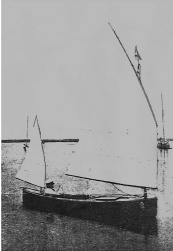 HONORARY MEMBER
HONORARY MEMBER
Warrington Baden-Powell, Royal C.C. of London, sailing his
famous canoe, "Nautilus II". International Cup challenger
1886. Illustration by Beech-Nut Packing Co.
1886

1933
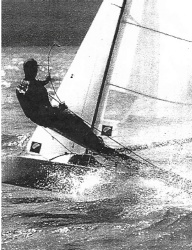
2000
Cruising Canoes
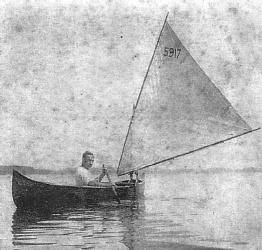
Tom Zuk in his William English "Undine I" --
1921 Winner of Open Canoe Sailing Trophy &
1920, 1921, 1922 ACA Record Combined, &
Admiralty Trophy 1921
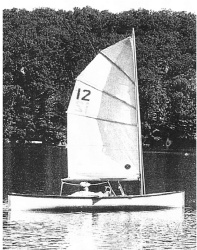
Larry Zuk in his own original "Osprey" -- 1978 Winner
of Open Canoe Sailing Trophy & 1979, 1997, 2002
Lady Bug, Admiralty, Wilkinson & others for 74 years:
1935 -- 2008, and still going.
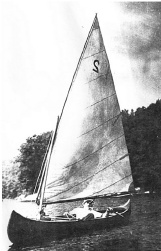
Tom Zuk 1956
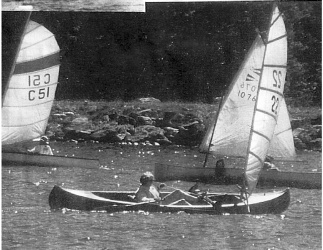
Mick Raffle, Sherrie Winkworth & Tom
Uebel -- 2006
Canvas Canoes
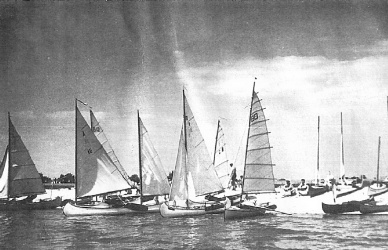
1930
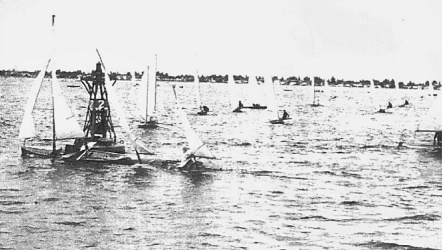
1930
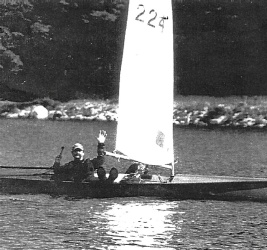
2007

2007










